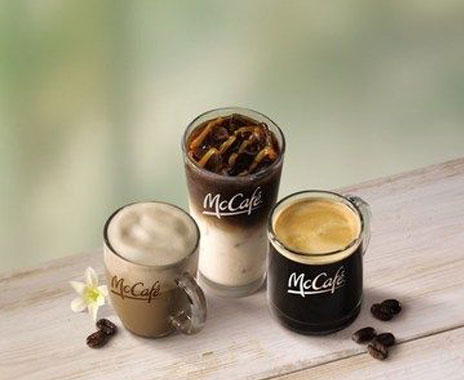California is one of those states that prides itself on being different. Think weather. Surfing. Avocados. Celebrity governors. Cabernet Sauvignon. Minimum wage. The list goes on.
And now, it seems, you can toss McDonald’s into that group. This is nothing new, exactly. The brand was born in the Golden State and has understandably deep ties to the region. In recent months, customers throughout the state, especially in the Northern zip codes, have enjoyed a different experience than the rest of us.
Earlier this week, McDonald’s restaurants in Sacramento, Stockton, and Modesto rolled out three new McCafé beverages, including hot and iced Caramel Macchiato, French Vanilla Cappuccino, and American. This came with new equipment in the kitchens of these units, which allows the operators to make mochas, lattes, and hot chocolate, and encompasses 170 locations in all. From March 20—26 a small offering will cost just $1, with prices returning to standard retail the following day.
Beverages are playing a big role in McDonald’s future plans. Coffee and fountain drinks have been discounted to $1 already this year. In fact, Northern California kicked off 2017 by offering a free small cup of coffee to its customers—a two-week promotion that featured Premium Roast Coffee made with 100 percent fire-roasted Arabaca Beans. No purchase was necessary.
This innovation is part of the chain’s broader strategy to boost comparable sales, which declined 1.3 percent in the fourth quarter in the U.S. McDonald’s credited that to the year-over-year comparison with All-Day Breakfast. Meaning, of course, that there was no comparison. Unlike many financial excuses, this is actually a rather valid one, but it bears a deeper question: What is McDonald’s next big thing?
This, too, appears to be in a California state of mind. On Wednesday, the company said it was giving customers in Monterey and Salinas, California, as well as Spokane, Washington, a chance to experience the first example of McDonald’s upcoming mobile ordering and pay system. Customers can now use the app, which is in beta pilot, at 29 restaurants in California. The 51 Spokane stores will join March 20. This, the company says, is designed to elicit customer feedback before the national launch hits 14,000 locations in Q4.
“We look forward to learning from our customers in these markets as they order ahead, pay within the app and choose one of the various ways to pick up and enjoy their favorite McDonald’s foods,” says Julia Vander Ploeg, vice president of U.S. Digital, in a release. “From the app to our restaurant operations, we’ve taken a fully integrated approach to ensure a seamless customer experience that we think our customers will love.”
How it works is simple. Guests can place the order in the app, head to their local McDonald’s, pay through the app, and then pick up the food at the counter, drive-thru or curbside delivery spot. It’s all done through geofencing technology for check-ins, which allows McDonald’s to determine just how close the customers are. In theory, this will result in freshly made food that’s ready for pick-up at the perfect time.
At the drive-thru, guests need to just read the order code to the crew.
This shouldn’t come as a surprise. McDonald’s, earlier in the month, outlined its path forward with a bull’s-eye on convenience and technology. The two main points: mobile ordering to 20,000 units by the end of 2017, and an accelerated growth in delivery. Also, the continued deployment of the “Experience of the Future” restaurant design—a model that features kiosk ordering and table service, and aligns with mobile ordering. McDonald’s plans to reimage around 650 restaurants this year, with a target of 2020 for the complete overhaul of its free-standing units.
Returning to California, McDonald’s also made a splash in February with a Crab Sandwich, available, you guessed it, only in the state. This time, it was (fittingly) the San Francisco Bay area that tested a Snow Crab meat sandwich mixed with diced celery and seasoned mayo dressing, served on a sliced sourdough bun and topped with romaine lettuce, tomato slices, and herbed butter. Developed with chef and TV personality Ryan Scott, the menu item was part of a continued experiment to regionalize McDonald’s menus in certain markets.
“After the overwhelming success of our local favorite, McDonald’s Gilroy Garlic Fries, we wanted to test our own take on the beloved crab sandwich,” said Nick Vergis, McDonald’s co-op president, in a statement at the time.
McDonald’s march into the future will continue to reverberate around the industry. If you want to witness the change first, just be sure to keep an eye to the West.








